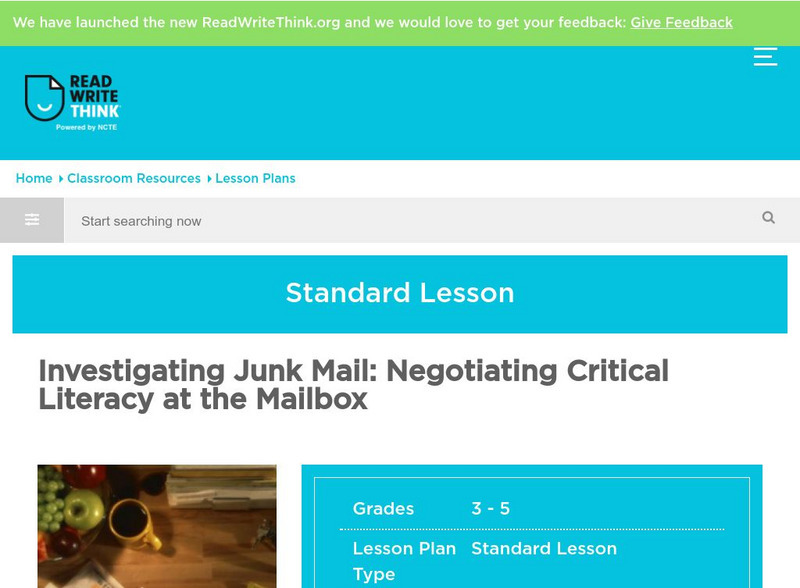Hi, what do you want to do?
Curated OER
Graphing Heart Rates
Students explore heart rates. They record pulse rates, predict which exercises cause a faster heart rate, make a chart, and graph the results. Students write an essay using the data to support their predictions. They write a hypothesis...
Curated OER
Science Habits of Mind
Students study good communication skills. In this communication instructional activity students write step by step instructions for a procedure.
Curated OER
"how To Think Like an Archaeologist" Suggested Pre-visit Activity for Historic Jamestowne
Students study grocery receipts to simulate the archaeological activity of classifying items. They discuss the receipts as if they were find lists.
Curated OER
A History of Conflict Resolution and the Jury System
Students study the history of the jury system in the United States. They enact a number of different types of trials including trial by jury. They complete a worksheet that compares the trials systems before writing a persuasive essay...
Curated OER
History at Work
Students study the history of farm machinery with a focus on farming in Ireland. For this farming history lesson, students study a picture of a farm object from the early twentieth century and complete a worksheet about the picture....
Curated OER
Paradox Worlds
Students view and analyze "Still Life," by Cornelis de Heem. They answer discussion questions about the painting, write similes, discuss symbolism, create a still life sketch, and create a paint box poem.
Curated OER
Introduction to Primary Sources
Students explore the usage of primary sources, what they are and how they originate. Artifacts are compared and contrasted as part of this historical inquiry as questions are formulated and conclusions drawn.
Curated OER
The World's Simplest Cartesian Diver
Have your class learn about buoyancy using this simple lesson. First, they bring in condiment packets and see what happens when they place it in a glass of water. Then, they use one of the packets to illustrate the concept of a Cartesian...
Curated OER
Mythology of the Ancient World
The mythology of the ancient world can provide motivating lessons that can help students learn about history.
Curated OER
Traveler's in Time
Learners analyze artifacts to become familiar with the Great Migration. In this migration lesson plan, students read an article and answer comprehension questions. Learners role play a migration scenario using an artifact to help...
Curated OER
Technology-commected Folklife Lesson Plan: Fables
Students discuss ways the stories were alike and different. The teacher demonstrate how to draw a Venn diagram using Microsoft Word. They label the two circles and enter the likenesses and differences on the diagram.
Curated OER
Moving Objects
Young scholars discover the history of the United States by examining the Great Migration. In this U.S. History lesson, students research the immigration movement on the Internet and complete a worksheet about the large population...
Pennsylvania Department of Education
Analyzing Numeric and Geometric Patterns of Paper Pool
Students use concrete and pictorial representation of geometric patterns to extend patterns. In this geometric patterns lesson plan, students identify patterns and extend them.
Curated OER
Time in a Teakettle
Students compare and contrast the development of teakettles. In this artifacts lesson, students divide into groups and examine different teakettles. Students complete an artifact analysis worksheet, draw a picture of their kettle and...
Curated OER
Brainstorming: A Strategy for Creative Productivity
In this brainstorming worksheet, students read directions on how to brainstorm with a group or as an individual. Students read 7 tips total.
Other
Research Assistant: For Students: Purpose Statement
This site gives advice on how to write an effective purpose (thesis) statement. The summary is given as answers to four questions: what? why? when? how?.
ReadWriteThink
Read Write Think: Junk Mail: Negotiating Critical Literacy at the Mailbox
Contains plans for three lessons that teach students to examine junk mail critically. In addition to objectives and standards, this instructional plan contains links to sites used in the lessons as well as assessment and reflection...
CommonLit
Common Lit: Units: 6th Grade Informational Unit: Success
Complete teaching unit for 6th Grade Informational Unit: "Success." Students will read six informational texts focusing on the essential question: "What does it take to be successful?" Students will gather information from their readings...





















